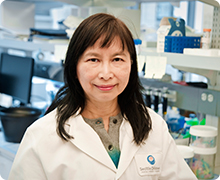Treatments for Hemophilia – Gene Therapy
Ultrasound-mediated gene delivery for hemophilia treatment
Technology Overview
Although viral gene therapy had success in animal models in recent clinical trials, many obstacles remain. Previously, Dr. Carol Miao’s team demonstrated that the ultrasound (US)-mediated gene therapy method can significantly enhance reporter gene transfer into the mouse and rat livers. This nonviral gene-transfer strategy can bypass many obstacles encountered by viral gene therapy. Most significantly, we have recently achieved therapeutic levels of factor VIII (FVIII) following US-mediated gene delivery into hemophilia A mice.

Dr. Carol Miao
In order to facilitate the eventual translation of these technologies into human application, we have developed ultrasound systems and new generations of transducers to successfully apply ultrasound technology for treating large tissue volumes in large animal models, including dog and pigs.
Recently, we have also synthesized and screened for the best custom-made, targeted microbubbles to further improve gene-transfer efficiency.
These projects will facilitate the translation of this novel technology into human application, and could change fundamentally the way hemophilia patients are treated, with better patient outcomes. We would like to explore the possibility of clinical trials using this new technology.
Stage of Development
- Pre-clinical in vivo
- Pre-clinical in vitro
Partnering Opportunities
- Collaborative research opportunity
- Sponsored research agreement
- Consultation agreement
Publications
- Noble-Vranish ML, Song S, Morrison KP, Tran DM, SunRR, Loeb KR, Keilman GW, and Miao CH., Ultrasound-mediated gene therapy in swine livers using single element, multi-lensed high intensity ultrasound transducers. Mol Ther Meth Clin Dev, 2018, 10:179-188
- Tran DM, Harrang J, Song S, Chen J, Smith BM, Miao CH., Prolonging pulse duration in ultrasound-mediated gene delivery lowers acoustic pressure threshold for efficient gene transfer to cells and small animals., J Control Release. 2018 Jun 10;279:345-354.
- Tan JK, Pham B, Zong Y, et al. Microbubbles and ultrasound increase intraventricular polyplex gene transfer to the brain. J Control Release. 2016 Jun 10;231:86-93.
- Sun RR, Noble ML, Sun SS, Song S, Miao CH. (2014) Development of therapeutic microbubbles for enhancing ultrasound-mediated gene delivery. J Control Release 182:111-20.
- Noble ML, Kuhr CS, Graves SS, Loeb KR, Sun SS, Keilman GW, Morrison KP, Paun M, Storb RF, Miao CH. (2013) Ultrasound-targeted microbubble destruction-mediated gene-delivery into canine livers. Mol Ter. 21 (9):1987-94.
Learn More
To learn more about partnering with Seattle Children’s Research Institute on this or other projects, email the Office of Science-Industry Partnerships.